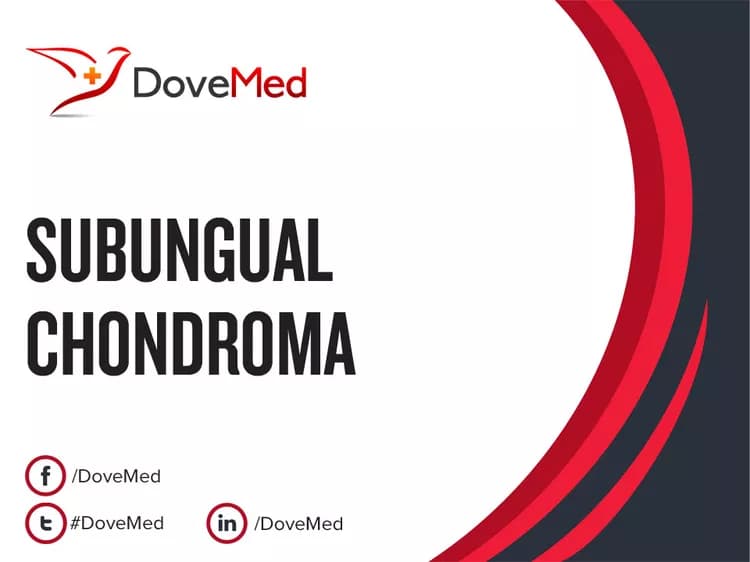
Subungual Chondroma
What are the other Names for this Condition? (Also known as/Synonyms)
- Chondroma of Nail Matrix
- Digital Subungual Chondroma
- Soft Tissue Chondroma of Nail Bed
What is Subungual Chondroma? (Definition/Background Information)
- A chondroma is a benign tumor of the cartilage; it usually arises in the bones. Chondromas arising in areas outside the bone, called extraosseous chondromas, are uncommon
- There are 3 types of extraosseous chondromas:
- Intra-articular or para-articular chondroma
- Juxtacortical chondroma
- Chondroma of soft parts
- A Subungual Chondroma is a chondroma of the nail affecting the tissue beneath the nail base, known as the nail matrix. It is the region from where the nail forms and grows from
- Subungual Chondroma is a tumor of soft parts (soft tissue) that is observed during middle-age. Because of the rarity of the tumor, it is often misdiagnosed. The tumor is typically diagnosed with the help of a biopsy
- Once a definitive diagnosis has been made, it may be surgically removed (excised). The prognosis of Subungual Chondroma is excellent with appropriate surgical treatment; permanent damage to the affected nail is generally uncommon
Who gets Subungual Chondroma? (Age and Sex Distribution)
- Subungual Chondroma is a rare tumor that is more commonly observed in middle-aged adults; 40-55 year’ age category
- A few cases have been observed in children too
- No gender predilection is observed and both males and females are affected
What are the Risk Factors for Subungual Chondroma? (Predisposing Factors)
- The risk factors for Subungual Chondroma are currently unidentified
It is important to note that having a risk factor does not mean that one will get the condition. A risk factor increases one’s chances of getting a condition compared to an individual without the risk factors. Some risk factors are more important than others.
Also, not having a risk factor does not mean that an individual will not get the condition. It is always important to discuss the effect of risk factors with your healthcare provider.
What are the Causes of Subungual Chondroma? (Etiology)
Currently, the exact cause of development of Subungual Chondroma is unknown.
What are the Signs and Symptoms of Subungual Chondroma?
The following signs and symptoms of Subungual Chondroma may be observed:
- The presence of a ‘usually’ well-circumscribed firm mass beneath the nail
- Subungual Chondromas are generally slow-growing and usually asymptomatic (causing no pain or other significant signs and symptoms)
- The lesion may be present either in the finger or toe
- It can cause deformation of the overlying nail
- The nail may become brittle and crack/break while remaining attached to the base
- In some cases, tumors on the finger may lead to a condition known as trigger finger. In this condition, the finger becomes locked in a certain fixed position due to involvement of the muscles by the tumor
How is Subungual Chondroma Diagnosed?
The diagnosis of Subungual Chondroma may be undertaken through the following tests and exams:
- A thorough physical exam and complete evaluation of medical history
- Radiological imaging studies of the affected finger or toe, via MRI or CT scans
- A tissue biopsy of the tumor is performed and sent to a laboratory for a pathological examination. A pathologist examines the biopsy under a microscope. After putting together clinical findings, special studies on tissues (if needed) and with microscope findings, the pathologist arrives at a definitive diagnosis. Examination of the biopsy under a microscope by a pathologist is considered to be gold standard in arriving at a conclusive diagnosis
- A differential diagnosis to rule out other conditions, such as fungal infection of the nail or splinter hemorrhage, presenting similar signs and symptoms may have to be undertaken
Many clinical conditions may have similar signs and symptoms. Your healthcare provider may perform additional tests to rule out other clinical conditions to arrive at a definitive diagnosis.
What are the possible Complications of Subungual Chondroma?
Generally, Subungual Chondromas are not associated with any serious complications. However, in some cases, the following may be noted:
- Severe pain
- The removal of the tumor may result in deformed nail (onychodystrophy); permanent nail deformity
- The tumor can rarely recur after its surgical removal
How is Subungual Chondroma Treated?
The treatment of Subungual Chondroma may involve the following measures:
- The healthcare provider may recommend a ‘wait and watch’ approach for small, asymptomatic tumors
- Simple excision and complete removal of the tumor and the overlying nail is the most effective treatment. The nail usually grows back after a certain period
- Follow-up care with regular screening and check-ups are important, since some tumors are known to return
How can Subungual Chondroma be Prevented?
Currently, it is not possible to prevent the formation of Subungual Chondroma.
What is the Prognosis of Subungual Chondroma? (Outcomes/Resolutions)
- With appropriate treatment, the prognosis of Subungual Chondroma is typically excellent, since the tumors are benign in nature
- The risk of recurrence is related to surgery; in most cases, the risk is minimal
Additional and Relevant Useful Information for Subungual Chondroma:
- Soft tissue chondroma is an infrequent benign tumor of the soft tissues, occurring near bones and joints. They are primarily composed of mature hyaline cartilages
The following DoveMed link will help understand soft tissue chondroma:
http://www.dovemed.com/diseases-conditions/soft-tissue-chondroma/
Related Articles
Test Your Knowledge
Asked by users
Related Centers
Related Specialties
Related Physicians
Related Procedures
Related Resources
Join DoveHubs
and connect with fellow professionals


0 Comments
Please log in to post a comment.